
Aula Orientalis
Scope & Guideline
Fostering Dialogue in Archaeology and History
Introduction
Aims and Scopes
- Interdisciplinary Research:
The journal promotes research that crosses traditional academic boundaries, integrating archaeology, history, linguistics, and cultural studies to provide a holistic understanding of ancient societies. - Focus on Ancient Near Eastern Civilizations:
Aula Orientalis primarily explores the history, literature, and archaeology of ancient civilizations such as Mesopotamia, Egypt, and their surrounding regions, aiming to illuminate their cultural and historical significance. - Philological and Linguistic Studies:
The journal publishes works that delve into the languages and texts of ancient civilizations, offering insights into their linguistic structures, literary forms, and historical context. - Archaeological Findings and Interpretations:
A significant portion of the journal's content is dedicated to new archaeological discoveries and their interpretations, contributing to the ongoing dialogue about ancient life and culture. - Cultural and Historical Contextualization:
The journal emphasizes the importance of understanding ancient texts and artifacts within their broader cultural and historical contexts, fostering a deeper appreciation of their significance.
Trending and Emerging
- Gender Studies in Ancient Cultures:
There is a growing trend towards exploring gender roles and representations in ancient societies, as seen in works that analyze gender dynamics in literature, rituals, and social practices. - Interdisciplinary Approaches to Archaeology:
Recent papers emphasize the integration of various disciplines, such as anthropology, sociology, and digital humanities, into archaeological studies, leading to more comprehensive interpretations of ancient artifacts and sites. - Cultural Reception and Influence:
Research focusing on how ancient cultures influenced each other and how their legacies are perceived in modern contexts is gaining traction, particularly in studies examining the reception of ancient texts and figures in contemporary literature and art. - Environmental Archaeology:
The exploration of environmental factors and their impact on ancient civilizations is on the rise, with scholars investigating how climate, geography, and ecology influenced cultural developments and societal changes. - Digital Humanities and Ancient Studies:
There is an increasing interest in utilizing digital tools and methodologies to analyze ancient texts and artifacts, enhancing accessibility and allowing for innovative forms of scholarship and collaboration.
Declining or Waning
- Traditional Textual Analysis:
There has been a noticeable decrease in purely traditional textual analysis without contextual frameworks. Scholars seem to be moving towards more interdisciplinary approaches that incorporate archaeological and sociocultural insights. - Comparative Mythology:
Interest in comparative mythology, particularly in the context of ancient Near Eastern religions, appears to be waning. This shift may suggest a preference for more nuanced studies that focus on specific cultural practices rather than broad comparisons. - Ancient Economic Systems:
Research focusing solely on the economic systems of ancient civilizations has diminished. Instead, there is a trend towards integrating economic studies with social and political contexts, reflecting a broader understanding of ancient societies. - Historicism in Literary Studies:
The focus on historicism in literary studies, which emphasized the historical context of literary works, has declined. Scholars are increasingly interested in theoretical frameworks that offer different lenses through which to analyze ancient texts.
Similar Journals
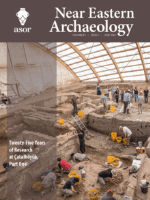
NEAR EASTERN ARCHAEOLOGY
Connecting Scholars to the Heart of Archaeological ResearchNEAR EASTERN ARCHAEOLOGY, published by University of Chicago Press, is a premier journal dedicated to the field of archaeology, particularly focusing on the rich cultural heritage and archaeological findings of the Near East. With an ISSN of 1094-2076 and an E-ISSN of 2325-5404, this esteemed publication provides a vital platform for scholars and practitioners to share their research, insights, and discoveries. The journal holds an impressive ranking in the Q1 quartile for both Archaeology and History in 2023, reflecting its significant impact within these fields and a robust history of scholarly contribution. The journal has been pivotal in shaping discussions around archaeological methodology, theory, and contemporary issues from 2002 to 2024, as it continues to reach a wide audience through various access options. With Scopus rankings placing it in the top percentiles for both History and Archaeology, NEAR EASTERN ARCHAEOLOGY represents an essential resource for researchers, professionals, and students alike, fostering the exploration and understanding of the region's archaeological narrative.

Journal of Hebrew Scriptures
Illuminating the Significance of Hebrew ScripturesThe Journal of Hebrew Scriptures is a leading open-access academic journal, published by University of Alberta, that has been at the forefront of biblical scholarship and Jewish studies since its inception in 1997. This journal presents an extensive collection of scholarly articles, critical analyses, and discussions that focus on the interpretation and significance of Hebrew Scriptures, making it an essential resource for researchers, educators, and students alike. The journal's commitment to open access ensures that it reaches a wide audience, promoting greater visibility and collaboration within the field. With its dedication to advancing the study of biblical texts, the Journal of Hebrew Scriptures plays a pivotal role in fostering academic discourse and disseminating innovative research to the global scholarly community. As an invaluable platform for the exploration of theological, historical, and cultural aspects of Hebrew Scriptures, it invites submissions that can enrich the understanding and appreciation of these ancient texts.
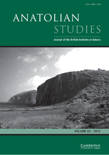
Anatolian Studies
Exploring the Depths of Anatolian HeritageAnatolian Studies, published by Cambridge University Press, stands as a premier forum for research in the fields of archaeology, cultural studies, and history. Established in 1951, this esteemed journal has consistently contributed to the academic discourse surrounding the rich and multifaceted history of Anatolia, earning its place in the Q1 category across multiple disciplines. With a notable impact factor reflected in its Scopus rankings, it ranks among the top journals in its fields: 78th in History, 155th in Cultural Studies, and 55th in Archaeology, showcasing its significant influence and recognition. This journal serves as an invaluable resource for researchers and scholars seeking to delve into the intricacies of Anatolian heritage, providing a platform for innovative research and critical discussion within the academic community. While it currently does not offer open access, Anatolian Studies continues to enrich scholarly resources and advance knowledge within its key areas of focus.
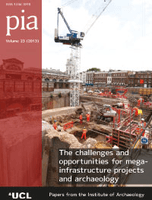
Papers from the Institute of Archaeology
Pioneering methodologies for a deeper understanding of history.Papers from the Institute of Archaeology is a distinguished academic journal dedicated to advancing the field of archaeology through rigorous scholarly contributions. Published by the University College London, Institute of Archaeology, this Open Access journal has been a vital platform for the dissemination of archaeological research since its inception in 1990, ensuring that knowledge is accessible to a global audience. The journal welcomes articles that explore diverse aspects of archaeology, including theoretical discussions, methodological innovations, and case studies from different geographical contexts. As a significant resource for researchers, professionals, and students alike, Papers from the Institute of Archaeology strives to foster dialogue and collaboration within the archaeological community. Its commitment to open access reflects the journal's mission to democratize knowledge and stimulate interest in the past among academics and the public.

Acta Classica
Illuminating the Classics for Contemporary UnderstandingActa Classica is a distinguished journal dedicated to the field of Classics, published by the Department of English in Classical Languages at the University of Free State, South Africa. With its ISSN 0065-1141 and E-ISSN 2227-538X, this journal has been a pivotal platform for scholarly discourse since its inception in 1973, notably converging and evolving significantly in its content from 2010 to 2023. Although it currently holds a Q4 classification in Classics, its Scopus ranking at #88 out of 170 in the Arts and Humanities reflects its relevance in academic circles, with a 47th percentile standing. The journal aims to publish high-quality research articles, reviews, and critical essays that not only explore the rich tapestry of ancient civilizations but also contribute to contemporary understandings of classical languages and literature. While its content is not openly accessible, Acta Classica remains an essential resource for researchers, professionals, and students who seek to deepen their knowledge and engagement with Classical studies.

ZEITSCHRIFT DES DEUTSCHEN PALASTINA-VEREINS
Contributing to the Academic Discourse on Contemporary Palestinian StudiesZEITSCHRIFT DES DEUTSCHEN PALASTINA-VEREINS is a distinguished academic journal published by VERLAG OTTO HARRASSOWITZ, focusing on interdisciplinary research in archaeology, cultural studies, history, and religious studies. With an ISSN of 0012-1169, this periodical has gained recognition for its valuable contributions to the understanding of historical and contemporary issues related to the Levant region, making it an essential resource for researchers, professionals, and students fascinated by these disciplines. The journal's performance in the academic community is bolstered by its Q2 and Q3 quartile rankings across various subject categories in 2023, including significant placements in cultural studies and religious studies, reflecting its impact and relevance. ZEITSCHRIFT DES DEUTSCHEN PALASTINA-VEREINS not only serves as a platform for scholarly discourse but also engages with current debates and methodologies, fostering a deeper appreciation for the complexities of Palestinian studies and contributing to a vibrant academic landscape. While the journal is not open access, it remains a critical venue for disseminating cutting-edge research and perspectives.
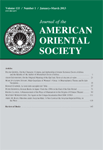
JOURNAL OF THE AMERICAN ORIENTAL SOCIETY
Advancing Scholarship in Cultural StudiesThe JOURNAL OF THE AMERICAN ORIENTAL SOCIETY, published by the American Oriental Society, is a prestigious academic journal based in the United States that serves as a vital resource for researchers and scholars engaged in the fields of Asiatic studies, cultural studies, and broader humanities. Established to foster scholarly communication, this journal presents rigorous peer-reviewed articles and critical analyses that explore the diverse cultural, historical, and linguistic dimensions of the Orient. With an impact factor reflecting its scholarly significance, it occupies a Q3 position in Arts and Humanities (miscellaneous) and a Q2 ranking in Cultural Studies as of 2023. Although it does not currently offer open access, the journal maintains a strong reputation for its scholarly contributions, making it an essential platform for disseminating research findings. By bridging gaps in knowledge and fostering interdisciplinary dialogue, the JOURNAL OF THE AMERICAN ORIENTAL SOCIETY remains a cornerstone for those committed to the exploration of Asian cultural heritage and philosophy, enriching the academic community's understanding in these vital fields.

Zeitschrift fur Assyriologie und Vorderasiatische Archaologie
Unveiling the Mysteries of the Ancient Near EastZeitschrift für Assyriologie und Vorderasiatische Archäologie, published by WALTER DE GRUYTER GMBH, is a distinguished journal in the field of archaeology, focusing on the rich histories of the ancient Near East and Assyrian studies. Established in 1886, this journal has a venerable tradition of contributing to scholarly discourse, continuously curating impactful research that positions it within the Q2 quartile in the domains of Archaeology and Arts and Humanities as of 2023. With an impressive ranking of #101 out of 413 in Arts and Humanities and #98 out of 354 in Social Sciences within Scopus, the journal serves as a vital resource for researchers, professionals, and students alike. Although it operates under a subscription model, the journal's extensive coverage—from its inception to the present day—ensures a comprehensive exploration of archaeological methodologies, discoveries, and theoretical frameworks. The journal's aim is to advance the understanding of the ancient civilizations of the Near East and to foster scholarly communication across international platforms, making it an essential venue for contemporary archaeological research.
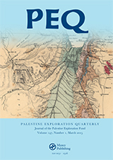
Palestine Exploration Quarterly
Exploring the Depths of Palestine's HeritagePalestine Exploration Quarterly, published by Routledge Journals, Taylor & Francis Ltd, is a leading academic journal that has been at the forefront of archaeological, historical, and cultural studies concerning Palestine since its inception in 1865. With an impressive Q1 ranking in multiple categories including Archaeology, History, Religious Studies, and Visual Arts and Performing Arts, the journal is recognized for its rigorous peer-reviewed content that significantly contributes to the understanding of cultural heritage and societal dynamics in the region. The UK-based journal offers an array of scholarly articles, reviews, and reports aimed at researchers, professionals, and students in the humanities and social sciences. With a strong focus on advancing knowledge and fostering academic discourse, the Palestine Exploration Quarterly remains an invaluable resource for those engaged in the exploration and interpretation of Palestine's rich history and heritage, now accessible through various academic libraries worldwide.

ARCHAEOLOGY
Innovative Research, Timeless DiscoveriesARCHAEOLOGY is a distinguished peer-reviewed journal published by the Archaeological Institute of America, focusing on the multifaceted aspects of archaeological research and its relevance to contemporary society. Established in 1966, this journal serves as a critical platform for scholarly discourse in the field, showcasing innovative findings, theoretical advancements, and methodological discussions related to archaeology. While it maintains a Q4 ranking within the disciplines of archaeology and arts and humanities, its contributions remain valuable for those engaging in archaeological studies or seeking to understand historical and cultural narratives. The journal is accessible in print, with an ISSN of 0003-8113 and an E-ISSN of 1943-5746, ensuring that a wide audience can benefit from its insights. Although currently not classified as Open Access, the meticulous peer-review process ensures a high standard of academic rigor, making it an essential source for researchers, professionals, and students alike who are dedicated to exploring the past through archaeological lenses.